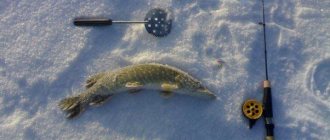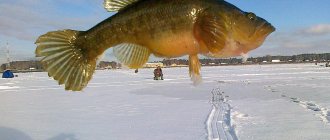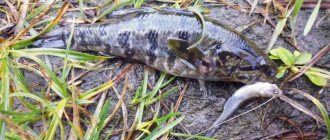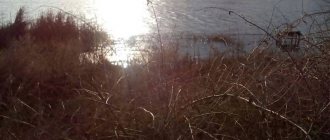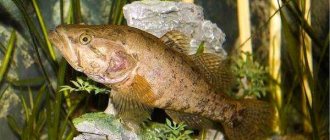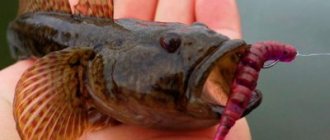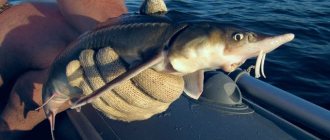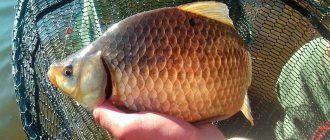Winter fishing for rotan with girders is carried out with the targeted catching of a large predator, from 300 grams and more. Some fishermen practice this type of fishing in winter just for fun, watching the murderous ruthlessness of nature. You catch a 50-gram small rotan, put it on a bait, and a slightly larger firebrand, 70 grams, immediately grabs it. In turn, you put it on the hook, too, and you catch a hundred-gram predator. And so on.
Winter fishing for rotan
For a long time now, winter fishing for rotan has been not just entertainment, but full-fledged fishing, especially in reservoirs where the population of this Far Eastern guest lives for a long time and there are individuals weighing up to a kilogram. The gastronomic qualities of rotan are excellent, but in order to catch it with cutlets, you need to try to find a decent size firebrand. An article about catching large rotan in winter.
If the bite is normal, then the firebrand sits on the hook one by one. This kind of fishing gets boring. Catching rotan on baits in winter is aimed at cutting off small fish and catching larger specimens. Rotan takes no worse on a rod than on a fishing rod. You just need to take into account some nuances associated with the greed of this predator. If you want to catch a firebrand of 100 grams or more, then the bait on the hook of the girder must be appropriate. If there are a large number of small firebrands in the reservoir, the main task in winter is to present the bait so that it has time to wait for a large predator before it is torn apart by the small ones.
Catching rotans in winter with a jig
To catch rotan with a jig, bait with bait is most often used, while reelless jigs can be very attractive to this gambling predator. Sometimes rotan takes them without bait, but the bites will be more frequent and greedy if you put a piece of a worm, several bloodworms, lard with meat streaks, something edible on the hook of the reelless hook, something edible, but not vegetarian, which rotan fundamentally cannot tolerate. This is a merciless predator. And if it were at least the size of a pike, it would probably attack people. If you look at its teeth and enlarge them in accordance with the size of the pike, then the rotan’s teeth will be more dangerous than those of the pike.
All perch jigs, including reelless baits, are quite suitable for fishing for rotan. Just like perch, rotan reacts positively to golden-coated jigs. These can be perch pellets consisting of half black tungsten and brass or electroplated gold plating. The size of such a jig can be within 5-7 mm. And these are quite large jigs, which are rarely used for perch, except perhaps on the deep edges. Rotans also enthusiastically attack “bug” type jigs of various colors, but preferably those with a golden coating.
Among the reelless jigs, you can choose the so-called “goats”, among which the “cat’s eye” jigs stand out. “Nail balls” also work well. Larger rotans are caught on reelless jigs, but, as already mentioned, these fish prefer that there is something edible on the hook, even a reelless jig. Classic drop-shaped jigs without attachments are no less successfully used. These can be baits of various colors with the addition of cambrics, beads, and hairs. The main thing is that such a jig has a suspension angle, which is typical for such jigs if the bait is made using technology.
A regular fishing rod is used. This can be a winter fishing rod with a reel built into the body, a ribbed handle and a long whip, in a word, a classic winter fishing rod, which is convenient because it can be placed near the hole and catch low-active rotan using a stationary bait with bait. Sometimes this tactic is the most effective. For fishing for gambling rotan, which happens on lakes during the period of first ice, especially in clear frosty weather, various fishing rods with a short nod and a large jig are best suited. The simplest nods for fishing for rotan are often used: from store-bought lavsan nods to pieces of a nipple or a silicone tube. You shouldn’t bother with the special elegance of the fishing line either. Rotan is not very picky about the fineness of the equipment. Therefore, to equip a winter fishing rod for catching rotan, a fishing line with a diameter of 0.12-0.14 mm is suitable.
The technique of playing with a jig is not much different from perch fishing. This can be rapid oscillations of the jig at the bottom, rises to the top while simultaneously playing the jig at a fast pace, or tapping the bait on the bottom. But this is all for catching active rotan. If a predator bites sluggishly, then, most likely, smooth play with bait or stand-up fishing will be more successful.
Traditional bloodworms and worms can be used as bait. But rotan will not refuse a piece of pork fat with meat veins, beef liver and lung, live and cut “white” fish, and the best bait may be chopped small rotan, especially a piece with a tail.
Even for catching rotan with a jig, bait can be used quite effectively, but for obvious reasons it should differ from bait for “white” fish. This can be a piece of liver or lung minced into minced meat. The particles must be very small in order to create a light food suspension in the water, which greedy rotans will definitely come for. But they will not be able to feed on such trifles, so they will turn their attention to your bait.
Equipment for vents
Rotan is caught using a girder according to all the same canons as with ordinary fishing rods. There’s no need to bother too much with the design – the simplest equipment will do for the firebrand. The fishing depth in winter is usually 0.5-1 meter. Sometimes the entire layer of water is filled with mud and algae, so the equipment must be placed above the thickets.
For most cases, a meter-long piece of fishing line 0.3-0.5, a sliding sinker, a double hook and a crossbar stick (flyer) installed on the hole is enough. The excess fishing line is wound around a stick and secured in the split. The design of the winter stand can be any - the main thing is that it is convenient for the fisherman to maneuver with them.
Rotan bites greedily and is not afraid of thick gear, so a metal leash on the bait will not hurt. The rotan will not immediately bite through the fishing line - the teeth are too small. Therefore, when fishing for interest, you don’t have to use a leash, tying the hook directly to the fishing line. However, during long-term intensive fishing, rotan can damage the fishing line over time - in this case, a leash on the girder is not superfluous.
When equipping a bait hook on rotan, it is better to hook live bait with a double through the gills - with such a landing, there are practically no slippages. The predator grabs the bait greedily, bites it and tries to swallow it, even though it is slightly smaller in size than the attacker. When a baitfish is caught on the back, the predator often simply pulls the bait off the bait with impunity.
Standard checkboxes
If there are pike and gizzards in the reservoir, serious ones are used. The toothy one, living in the pond with the rotan, does not disdain it, and may well attack such a plant in winter. In such reservoirs, bait stations must be equipped in accordance with all the rules of winter pike rigging. If you climb a little further and deeper, into sparsely populated areas, you can easily find a backwater where giant rotans live, weighing from 500 grams to a kilogram. If a smaller rotan simply sluggishly moves the tackle when biting, then such a one will raise the flag and unwind the fishing line - all according to the laws of the fishing genre. For this kind of fishing, it is better to use serious fishing rods - with flags, reels and a supply of fishing line.
Mormyshki on rotan
To catch rotan using a jig, models are selected that imitate the behavior of aquatic insects that make up the main food supply of this fish. Winter jigs have many modifications. The weight of the bait must correspond to the fishing conditions. For example, for catching rotan in still water from ice, lead models are suitable, and when fishing even in a slight current or when the fishing rod is equipped with monofilament, then it is better to install tungsten jigs.
Rotan bites well on baitless jigs during the freeze-up period. High catchability is characterized by:
• Devil. This bait is equipped with three hooks and perfectly imitates the behavior of an insect in the bottom layer of water. The more varied the bait is, the higher the likelihood of a bite;
• Witch. This is the same devil, but on this jig three hooks are attached with rings and are movable. The movement of the hooks during play increases the resemblance to insects. These baits are usually made by hand;
• Nymph. This baitless jig for rotan is perfect for fishing in still water. Due to the design features (truncated drop) during the game, when falling, it moves to the side. This is an excellent imitation of insect behavior;
• Uralka. This jig, which has the shape of an elongated drop, is rightly called universal. Many species of fish bite on it with a bare hook and with bait. This bait comes in tin, lead and tungsten.
Bait for girders
For catching rotan with girders, smaller firebrands are most often used as bait. The cannibalistic predilections of rotan have long been known. And if you hang a 100-gram rattan on a hook, you will catch a 150-gram one. Therefore, to catch decent specimens, you need to use large bait.
It all depends on the characteristics of the reservoir and the time of fishing. In one place, a weighty rotan will be easily caught with a small one, or a piece of it (tail) on a hook. In another, the fish or bait is immediately attacked by small things that are barely able to swallow the bait. In this case, you need to hang a large live bait or a huge piece of lard or chicken skin (100 grams or more) on the hook.
An interesting solution is to place the bait in a bag (minced rotan) made from women's tights - such stray will stay on the hook much longer and, perhaps, will survive until the approach of an adult predator. As bait for rotan, you can use any meat and fish offal, various live bait. But the firebrand works best on rotan, chicken skin or lard.
Tackle for rotan in winter
During thaws, a winter float rod is used for fishing for rotan in reservoirs with standing water. To attract fish to the fishing site, bait should be used. Chopped worms, bloodworms and animal waste are suitable as bait. It is impossible to miss the bite of rotan during stationary fishing. It usually self-cuts. The main thing is to securely fasten the fishing rods to the ice surface.
Features of tactics
You can catch rotan with girders just for fun, placing a couple of pieces next to the fishing rods. If the goal is to catch as many more normal-sized fish as possible, then the installation of baits needs to be systematized. Such fishing will be laborious, but it will bring a heavier firebrand. In promising places, all the holes are drilled at once, and the flags (bet) are set empty in them one by one. Then we catch small rattans with a fishing rod, a little more in number than the set supply, and equip them. The bets can be equipped with bells - this will make it easier to record a bite in the desired hole amidst the running around. Bait for rotan is not always used, but its use can lure the rotan patriarch out of its writhing.
When it starts to bite, we simply go around all the gear, check it, put larger and larger live bait, until the size limit is revealed. Then we hang live bait on the hook slightly smaller than the size at which there are no longer any bites. This way we will catch only the largest individuals. This tactic requires constant running between the girders and catching live bait with a fishing rod. But it justifies itself - it is important to choose a certain rhythm. Instead of 300 finger-sized fish per cutlet, several dozen 200g are better suited. rotanov.
Subscribe to the channel:
My YouTube channel RYBAFAN on fishing:
We're OK
Equipment of the vents
The author uses ordinary store racks with flags. The only thing that needs to be improved after purchase is the flags themselves. It is better to glue them so that they do not fly off the spring. Also, when purchasing, you need to pay attention to the tuck - it should be as thin as possible so that the vent is triggered by just one touch. If you can’t buy one, then the problem can be solved with a match. It is placed in the tuck with one end, which must be sharpened, and the other is simply split in half and the fishing line is already placed in it as required. If a match jumps out and gets lost, it’s not a problem, right while fishing you can put another one in a matter of seconds. As you know, neither rotan giblets nor worms, unlike live bait, can pull the line out of the pinch, so if this happens, then this is only a direct indication of a bite.
You can also use the second option for equipping the girder - with a load. A large jig is used as a load; you can even use a small winter spinner. The hook should be large enough - about number 10 - so that it is convenient to plant worms on it in cold weather. The spoon is even better - it is long and easier to remove from the fish’s mouth. In this case, the fishing line is not tucked, and the flag hangs only under the weight of the load. At the moment of a bite, the rotan grabs the load, the spring is unloaded and the flag goes up or begins to swing - this is a signal of a bite.
Currently reading
How to properly place bloodworms on a hook
The best baits for bream in any season
One of the disadvantages of this method is poor sensitivity in strong winds - the flags sway under its influence. Also, not everyone in their fishing arsenal has unnecessary spinners or large jigs of suitable weight, under which the spring bends to equip all the jigs. If desired, you can equip some of the girders in a classic way, through a tuck, and some - through a load and see which is more convenient.



